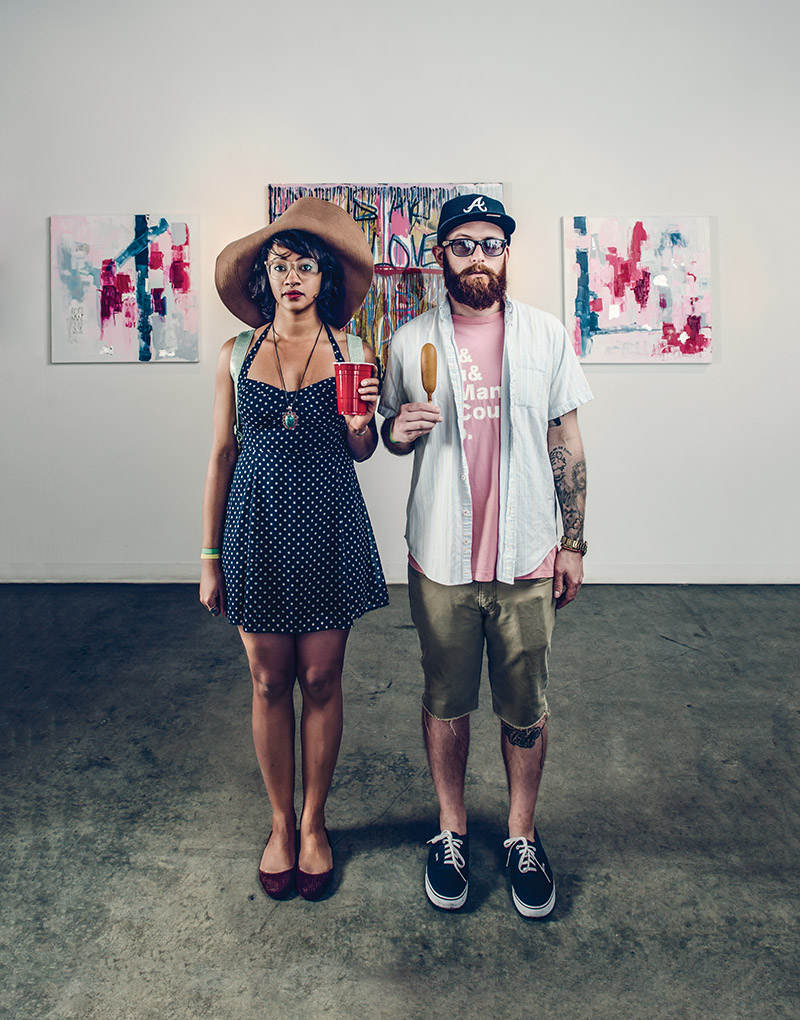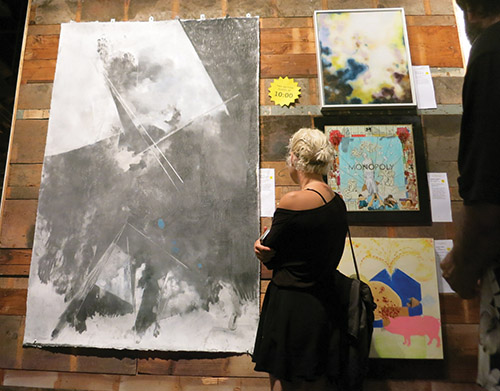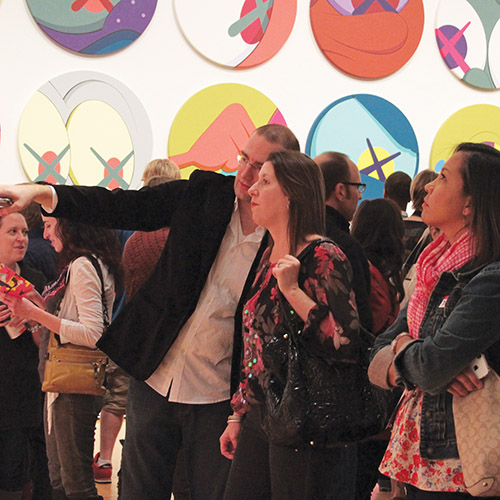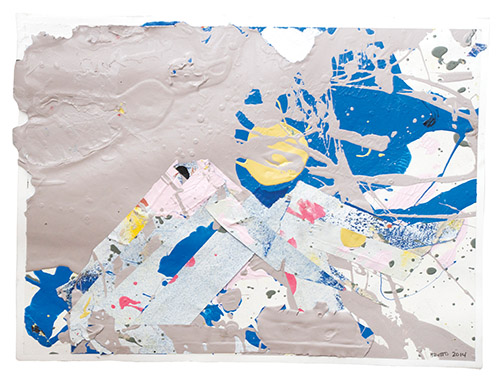The sun shines, birds sing, dogwoods bloom, and weekends brim with festivals. It’s time to grab a beer, take in some music. . . buy some art?
Hold on a minute. Atlanta’s festival culture—which, thanks to our mellow climate, is basically a year-round phenomenon—may delude us into thinking we’re supporting the creative class. But it’s a misconception that art fests are a boon to artists or the city’s art scene. In truth, Atlanta’s art industry struggles, even as our restaurant scene thrives, new development flourishes, and the housing market rebounds.

“Of course they’re fun,” says longtime art advocate Susan Bridges, owner of Whitespace gallery in Inman Park. “But many of the artists who participate in these festivals travel the [regional] circuit and don’t have a stake in trying to develop a true art culture in the city.”
Although it’s possible to pick up affordable art at one of the myriad festivals that pop up like daffodils each spring, don’t count on scoring an investment piece or supporting a recent art school grad. Festival booth rental can run several hundred dollars, and “that financial commitment usually excludes art students and local emerging artists,” says Mark Baseshore, who co-owns Beep Beep Gallery in Midtown. It also means that, to recoup the cost, even the most ambitious artist will be leery of showing innovative or inventive material, he says. Instead, it’s all about what sells. Atlanta artist R. Land, who has participated in the Inman Park Festival for more than a decade, says that he tends to show his prints and “more accessible fare,” such as magnets and wooden wall art, at the festival; he saves most of his original works for gallery and pop-up shows.
Robin Bernat, owner of the Westside’s Poem 88, says that some of her best young clients are not locals, but L.A. and New York art directors passing through town for film shoots. “There are definitely some [younger local collectors], but not enough,” says Robin Sandler at the Westside gallery Sandler Hudson, who relies on a consistent group of older, longtime collectors to support artists she represents, including Pam Longobardi and Mario Petrirena. Although schools like SCAD Atlanta and Georgia State turn out artists each year, opportunities for fresh talent to exhibit and sell their works here are diminishing.
Museum and gallery attendance among adults has dropped significantly nationwide—down 21 percent from 2002 to 2012, according to a report from the National Endowment for the Arts. And Georgia is dead last in per capita state funding for the arts, says Ryan Stubbs, research director at the nonprofit National Assembly of State Arts Agencies.
What would help turn this grim reality around? For one thing, if the young and well-heeled—like many who frequent festivals—replenished the aging ranks of Atlanta’s established collectors. On the flip side, the arts scene could stand to capitalize on the convivial spirit of festival culture. After all, festivals are fun and unpretentious, and have beer.
Several galleries have gotten wise to how a party atmosphere can attract not just art world insiders but also the culturally curious. Whitespace openings have included drag queens, craft beer, hot dogs, signature cocktails, and food trucks to show that culture and fun can go hand in hand, while presenting art in an unintimidating context. A Whitespace pop-up at Ponce City Market in January 2014 featuring painter Tommy Taylor demonstrated the potential for moving outside the art world’s cloistered comfort zone. The opening for Taylor’s buzzy “Senga,” an installation in which Japanese-style line drawings bled out of frames and onto the walls of the gallery space, featured Moscow Mules and drew a large, diverse crowd. Events like the annual Art Party thrown by the Atlanta Contemporary Art Center, the series of exhibitions and lectures put on every October by Atlanta Celebrates Photography, and the periodic Flux Project gatherings attract audiences from across Atlanta’s ethnic and economic spectrum.
Ultimately, arts support is about more than buying a painting, says Beep Beep co-owner James McConnell. “A vibrant scene needs artists, curators, collectors, critics, fans, and documenters in equal parts.”
Arts patronage 101
If you want to support the arts—and to ensure your dollars go to local talent—here are a few suggestions.

Photograph by Terry Kearns
Auctions
Parties and collecting opportunities rolled into one. Three of the best annual events: Art Papers (winter), the Hambidge Center (spring), and Atlanta Celebrates Photography (fall). The 2015 Hambidge auction takes place May 30 at the Goat Farm.
Indie Galleries
Small but mighty spots include Kai Lin, Mint, Beep Beep, and Kibbee galleries, as well as the Low Museum of Contemporary Culture. Many offer work from $200 to $2,000. In April, check out Craig Cameron’s prints and Heather Greenway’s paintings at Kibbee, Mike Germon’s collages at Beep Beep, or student works at Mint.

Photograph by Abel Klainbaum
Memberships
An annual membership at a larger institution—such as the High Museum of Art, the Atlanta Contemporary Art Center, the Michael C. Carlos Museum, and the Museum of Contemporary Art of Georgia—lets you demonstrate that programming and artists matter to you. Membership has privileges, of course, including free lectures, free or discounted admission, and sneak peeks of upcoming shows.
Collectors Clubs
Ready to go deeper? Clubs provide a forum to talk art in an engaging social setting. Check out Mary Stanley’s Young Collectors Club, which features talks from museum curators and regional artists, as well as studio visits and art-themed trips. Art appraiser Spalding Nix’s long-running Culture Club offers lectures by art world insiders (recent examples: NYC fashion photographers, the curator of England’s royal palaces). Also try: the High Museum’s Young Professionals and Art Partners groups. WonderRoot community arts organization took a model from the local food movement with “community-supported art.” Its CSA allows donors to underwrite emerging artists and to collect small works by the supported talent.

Photograph by Caroline C. Kilgore
Festivals
Finally, choose wisely and you can find some good local art at festivals. Art world insiders like Kibbee Gallery director Ben Goldman help to jury the Decatur Arts Festival Fine Arts Exhibition, which typically draws an impressive roster of talent. Last year’s show, staged in the Dana Fine Arts Building at Agnes Scott College, included Atlanta-based conceptual sculptor Leisa Rich, whose works are in the permanent collections of the Dallas Museum of Art and the Kamm Foundation. This year’s Decatur festival takes place May 23 and 24.
This article originally appeared in our April 2015 issue.














